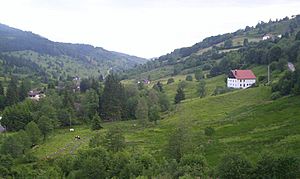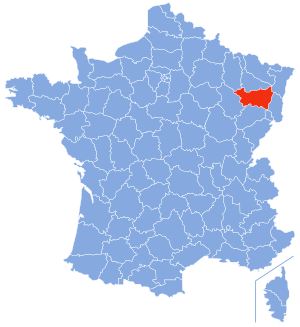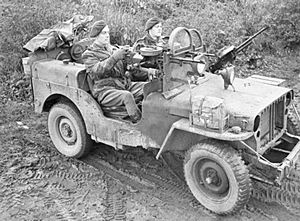Operation Loyton facts for kids
Quick facts for kids Operation Loyton |
|||||||
|---|---|---|---|---|---|---|---|
| Part of Western Front | |||||||
 Typical Vosges mountains landscape |
|||||||
|
|||||||
| Belligerents | |||||||
| Commanders and leaders | |||||||
| Strength | |||||||
| 91 men 2nd Special Air Service Section from F Squadron, Phantom signals unit Unknown numbers of the French Resistance 3 Jedburghs from Team Jacob 1 downed Airman 622 Sqn Royal Canadian Air Force |
Elements of the 17th SS Panzergrenadier Division Götz von Berlichingen | ||||||
| Casualties and losses | |||||||
| Special Air Service 14 killed and another 31 captured and executed. Phantom signals section 3 killed 210 French civilians arrested and sent to concentration camps where 140 died. |
Unknown | ||||||

Operation Loyton was a secret mission by the Special Air Service (SAS) during World War II. The SAS is a special forces unit from the United Kingdom. This mission took place in the Vosges department of France.
The operation lasted from August 12 to October 9, 1944. The SAS team was parachuted into the Vosges Mountains. Unfortunately, the German Army was strengthening its forces in that area at the same time. This was because General George Patton's American Third Army was advancing.
Because of the German presence, the SAS team's location was quickly discovered. The Germans then tried to find and destroy the SAS unit. As their supplies ran low and German pressure grew, the SAS soldiers were told to split into smaller groups. They had to try and make their way back to Allied lines. During the fighting, 31 SAS men were captured by the Germans. Sadly, these men were later executed.
Contents
What was the Vosges Region Like?
The Vosges is a region in northeastern France. It is located close to the German border. In 1944, this area did not have many people living there. It was mostly made up of wooded hills, green valleys, and small, quiet villages. This made it a good place for a small, fast-moving military group to operate.
In late 1944, General Patton's American Third Army was moving towards the Vosges. However, they had moved so fast that their supplies could not keep up. So, they had to stop at Nancy. To stop the American advance, the Germans sent more troops into the area. These included soldiers from the 17th SS Panzergrenadier Division Götz von Berlichingen.
The Secret Mission Begins
A small group of SAS soldiers, led by Captain Henry Druce, parachuted into the Vosges on August 12, 1944. Their landing spot was in a very wooded, mountainous area. This was about 40 miles (64 km) west of Strasbourg.
The first group's job was to connect with the local French resistance fighters. They also needed to explore the area. They had to find targets for attacks and locate a good spot for the main SAS force to land.
Arrival of the Main SAS Force
The main group of SAS soldiers arrived 18 days later, on August 30, 1944. This group was led by Lieutenant Colonel Brian Franks. Their landing had some problems. A container full of ammunition exploded when it hit the ground. A French resistance member helping with the containers died after eating plastic explosive. He thought it was some kind of cheese.
Also, a Frenchman was found nearby, supposedly picking mushrooms. The resistance fighters thought he might be a German informer. They held him, but in the confusion after the explosion, he grabbed a Sten gun. He was shot while trying to escape.
Fighting the Germans
The next day, the SAS began patrolling and setting up observation posts. They quickly realized that the Germans knew they were there. There were many more German soldiers in the area than they had expected. A force of 5,000 Germans was moving up a valley near the village of Moussey. This was very close to the SAS base camp.
The SAS soldiers were very active. They patrolled aggressively, carried out sabotage attacks, and had many gunfights. This made the Germans believe they were fighting a much larger force than they actually were.
On September 19 and 20, more SAS reinforcements arrived by parachute. These included six Jeeps and 20 more men. The Jeeps were armed with Vickers K and Browning machine guns. These vehicles allowed the SAS to change their fighting methods. The Jeep patrols attacked German road convoys and staff cars. One patrol, led by Captain Druce, even drove into Moussey. A German SS unit was gathering there. The SAS drove through the town, opening fire and causing many casualties.
German Actions Against Civilians
The Germans could not find the SAS base. They knew the SAS could not operate without help from the local people. To get information about the SAS camp, the Germans arrested all the men in Moussey between 16 and 60 years old. This was a total of 210 men. After being questioned, they were sent to concentration camps. Only 70 of these men returned home after the war.
On September 29, 1944, Captain Druce was sent to cross back into American lines. He carried important German military information that the resistance had found. Captain Druce managed to pass through German lines three times to reach safety.
Ending the Operation
By early October, General Patton's army was still stuck, and supplies were running out. It became clear that the Americans would not be able to rescue the SAS team soon. The operation had only been planned to last two weeks, but it had now gone on for over two months.
Lieutenant Colonel Franks decided to end the mission. He ordered his soldiers to split into small groups. Each group had to make its own way back to Allied lines, about 40 miles (64 km) away. One patrol was attacked by German SS soldiers, and three men were killed. A fourth man, Lieutenant Peter Johnsen, was wounded but escaped. Sadly, 34 other SAS men did not make it back to Allied lines.
What Happened After the War?
After the war ended, Lieutenant Colonel Franks began looking into what happened to his missing men. It was known that three men with Lieutenant Johnsen had been killed. Also, 10 men had been buried in the cemetery at Moussey.
The SAS unit was officially closed down in October 1945. Before this, a special team was formed to investigate war crimes, including what happened after Operation Loyton. This team learned about a German order that said all captured commandos should be executed.
In July 1945, the French told Franks that the bodies of some SAS men had been found. They were in a place called Gaggenau in the French occupation zone of Germany. Franks sent the investigation team to the area.
The Fate of the Captured Soldiers
The investigation found that 30 of the 31 missing SAS men had been murdered. This was done by a German security service called the Sicherheitsdienst (SD). Some of them were killed at the Natzweiler-Struthof concentration camp in the Vosges mountains. The fate of one man was never discovered.
Erich Isselhorst, a German officer in Strasbourg, was found guilty of ordering the murder of the British prisoners of war. He was sentenced to death by a British court in June 1946. He was then handed over to the French. A French court also sentenced him to death in May 1947, and he was executed in Strasbourg in February 1948.
Isselhorst had ordered the execution of the captured British SAS members. He also ordered the killing of French civilians, three French priests, and four American airmen. The prisoners were taken across the Rhine river to Gaggenau on November 21, 1944. The leader of the execution group, Karl Buck, thought it was not a good idea to leave mass graves of Allied soldiers so close to the front line.
The prisoners were first held in a local jail. Then, around November 25, they were taken to a nearby forest. They did not know what was going to happen to them. In groups of three, they were shot in the head in a bomb crater. One prisoner tried to escape but was also killed.
Besides Isselhorst, his second-in-command, Wilhelm Schneider, was also executed for these serious wrongdoings in January 1947. Karl Buck was also sentenced to death by British and French military courts. However, his sentence was changed, and he was released from prison in 1955.

Remembering the Victims
In 2003, a memorial was built at Moussey to remember those who were murdered. It lists the three men from the Phantom unit, the 31 SAS men, and 140 French civilians. It also remembers one British and two French service women from the Special Operations Executive. These women had also been caught up in the search for the SAS camp. There is also a memorial to Operation Loyton at the National Memorial Arboretum in Staffordshire, England.


